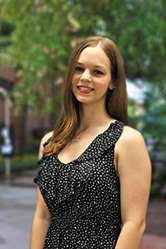Biochemistry and Molecular Biology
“A Flexible Approach to Treating the Ebola Virus”

The Ebola virus is at the center of the world’s stage due to the recent outbreaks in West Africa. Filoviruses such as Ebola are among the deadliest pathogens known, with fatality rates reaching near 90 percent. Despite dire need, there is no FDA-approved treatment or cure. Presently there are several nucleoside analogues being investigated, including the carbocyclic nucleoside 3-deazaneplanocin A (3-deazaNpcA). The proposed mechanism of action for 3-deazaNpcA is the inhibition of S-adenosylhomocysteine hydrolase (SAHase). Inhibitors of this enzyme indirectly inhibit DNA methyltransferase through a biofeedback mechanism. This halts S-adenosylmethionine-dependent methylations of the 5′-cap of mRNA, leading to defective viral transcription and translation, inhibiting viral replication. For this project, the modified adenine base in 3-deazaNpcA is “split” into its imidazole and pyridine components, remaining connected by a single C-C bond to give the target compound Flex-3-deazaNpcA. This will allow the base to adjust to form non-canonical binding interactions, without losing the integrity of the functional groups required for recognition, hence adopting an optimum conformation within the enzyme binding site. This strategy has been successful in multiple preliminary studies. Thus, endowing the 3-deaza scaffold with flexibility should prove strategic in terms of increased potency against Ebola.
Who is your mentor for your research, scholarship, or artistic project? How did you arrange to work with this person?
Dr. Katherine Seley-Radtke. Through the Meyerhoff Scholars Program, I was given the opportunity to contact her and arrange a meeting, at which point she offered to let me spend a couple weeks in the lab to see if I enjoyed her research or not.
How did you know this was the project you wanted to do?
After working in the lab for a few days, I knew that this project would give me a sense of accomplishment, as well as allow me to feel like I was making an impact on real world problems.
Is this your first independent research?
Yes, this is my first independent research project.
Do you get course credit for this work?
I am enrolled in CHEM 499 each semester, which allows me to get course credit depending on how many hours I plan to put in each week.
How much time do you put into it?
Depending on how many exams I have in a week, I try to work 10-15 hours per week during the school year. During the summer and winter, I try to put in 40 hours per week.
How did you hear about the Undergraduate Research Award (URA) program?
Dr. Seley-Radtke encouraged me to apply for the URA program.
Was the application difficult to do?
The application was not difficult. While the description of my research was not easy to write, it allowed me to practice explaining my work to someone who may not be experienced in my field.
How much did your mentor help you with the application?
My mentor let me work on the application until I had completed it, and then she did a final review to make sure that everything was correct and well written.
What has been the hardest part about your research?
The hardest part about my research is how often I hit a dead end. With organic synthesis, it is very easy for a reaction to not go as planned and to fail, which means that I must go back to the beginning of the entire project and start again. This can happen even on reactions that I have done many times before, and so it is quite unpredictable when this will happen and set me back.
What was the most unexpected thing?
The most unexpected thing about my research is the incredible array of colors I am able to make (either intentionally or not)! During my first month, I managed to make a bubble gum pink solution, and while it was not the product I was looking for, it still makes for a good story. Just this past spring, I created a turquoise blue solution, which was quite pretty.
How does your research relate to your work in other classes?
The research relates to a lot of my science classes. Since I work in drug synthesis, many of the projects in my lab relate to diseases studied in my biology classes, while the actual chemistry behind the way the products are formed relates to my chemistry classes.
What else are you involved in on campus?
On campus, I am the President of the American Chemical Society (also known as the Chemistry/Biochemistry Council of Majors) for the second year in a row. I also am a member in the UMBC Symphony Orchestra.
What is your advice to other students about getting involved in research?
I tell other students who want to get involved in research, but are afraid to reach out to faculty, to just go for it. There is no harm in sending an email and requesting a meeting. Even if the faculty who you are interested in has no openings in the lab, they may be able to refer you to someone else who would be willing to meet with you.
What are your career goals?
Upon my graduation from UMBC, I will attend graduate school to obtain a PhD in neuroscience. After that, I hope to become a research professor at an institution, simultaneously conducting research and teaching classes.
9/10/2021